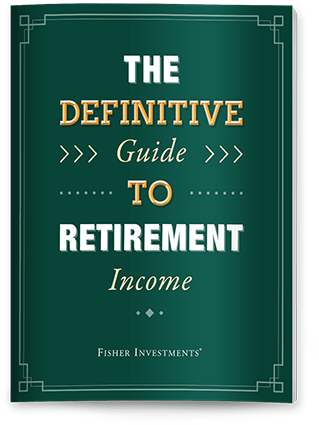Exchange-Traded Funds (ETFs): Benefits and Potential Drawbacks
What Are ETFs?
Like mutual funds, exchange-traded funds (ETFs) are securities that invest in a “basket” of underlying stocks, bonds or other securities. Unlike mutual funds, which typically trade once a day after markets close, ETFs trade throughout the day on stock exchanges.
ETFs can be actively managed. That means the ETF’s investment manager tries to outperform a specific benchmark. ETFs can also be passively managed. That’s where the ETF tracks the performance of a specific index, market or sector.
ETFs have grown in popularity since their inception in the early 1990s. They are now available across nearly every major market, sector and asset class.
Here, we describe some of the potential benefits and drawbacks of ETFs to help you determine if these securities are right for you.

See Our Investment Guides
The world of investing can seem like a giant maze. Fisher Investments has developed several informational and educational guides tackling a variety of investing topics.
-
Potential Benefits
-
Potential Drawbacks
-
Possible Tax Implications
Potential Benefits of Investing in ETFs
- Lower Fees: ETFs are often less expensive than comparable mutual funds, though costs can vary. Additionally, ETFs usually don’t charge the buying, selling or marketing fees more common with mutual funds.
- Liquidity: ETFs trade throughout the day like shares of stock. That means they generally offer better liquidity than comparable mutual funds.
- Access to Diversification: ETFs offer a relatively cost-efficient way to diversify an investment portfolio. Investors who lack the funding to properly diversify a portfolio with individual securities may find ETFs useful. (If you have larger amounts to invest, we believe other options may do a better job helping you reach your long-term investing goals. More on that below.)
Potential Drawbacks of Investing in ETFs
- Lack of Personalization: ETFs are not tailored to your investment goals. That means accommodating your unique needs can be difficult with ETFs. For example, most ETFs won’t allow you to restrict certain companies from your portfolio. If you’re a high net worth investor, you may be better off having a customized portfolio tailored to your preferences and designed to achieve your individual financial goals.
- Tax Disadvantages: ETFs may limit your ability to minimize capital gains taxes. This is an important consideration for some high net worth investors. While ETFs may be more tax efficient than mutual funds, offsetting capital gains with capital losses is often much easier with individual stocks and other securities.
- Less Cost-Efficient: If you own a larger portfolio, buying individual stocks and bonds may be more cost-efficient than investing in an ETF. With a larger portfolio, the relatively small ETF fees could add up and eat into performance.
- Overconcentration: You may unintentionally derail your asset allocation strategy if you invest in multiple ETFs with similar fund holdings. That’s because too much overlap in holdings could lead to overconcentration. In addition, holding too much of a single asset can add unintended risk to the portfolio. We believe true diversification means understanding how each of a portfolio’s components works together to meet your long-term objectives.
Possible Tax Implications of Owning an ETF vs. Owning Individual Securities
Consider a hypothetical ETF with a net annual return of 0%. This ETF has two securities: one experienced significant gains during the year, while the other experienced heavy losses. An investor in the ETF may not be able to offset capital gains in the overall portfolio if the ETF itself didn’t lose value. If the investor owned the underlying securities, however, harvesting the losses from the security that fell significantly may be possible.*
*The contents of this document shouldn’t be construed as tax advice. Please contact your tax professional.
A Word on “Passive” Investing and ETFs
Passive investing often involves buying an investment and holding it for the long term. Passive investors commonly look for investments that mimic market indexes (e.g., passive ETFs).
Sounds easy, in principle. Unfortunately, many passive investors often abandon their hands-off attitude when market volatility hits.
This is understandable. Remaining passive can be mentally trying when markets plummet. Some ETF investors react emotionally. They try to time the market, buying ETFs only to sell when they see the market decline.
In short, they end up betraying their intended passive strategy by actively buying high and selling at the wrong time.
Ken Fisher Debunks: “Passive Investing Is Easy”
Fisher Investments’ founder, Executive Chairman and Co-Chief Investment Officer Ken Fisher explains why passive investing—for example, buying a low-cost index fund and holding it—isn’t as easy as many believe. Ken believes a passive approach can be effective, but notes most investors fall prey to their own emotions amid developing market trends and are unable to remain passive in the long term.
A Better Approach
All the available options can make it difficult to determine if ETFs are right for you. This becomes more important as your portfolio grows. If you have a portfolio of $1,000,000 or more, we believe you may benefit from working with a fiduciary—an investment adviser who puts you first.
Fisher Investments is happy to provide portfolio reviews to qualified investors with $1,000,000 in investable assets. We can look at the ETFs and other assets you hold to identify overlaps in underlying assets. We can also help you determine whether you might benefit from direct investments.
Our clients receive specific asset allocation and investment recommendations aligned with their personalized financial goals, along with client service from our dedicated client service teams.
For more information, request an appointment or learn more about Fisher Investments through one of our many guides.




